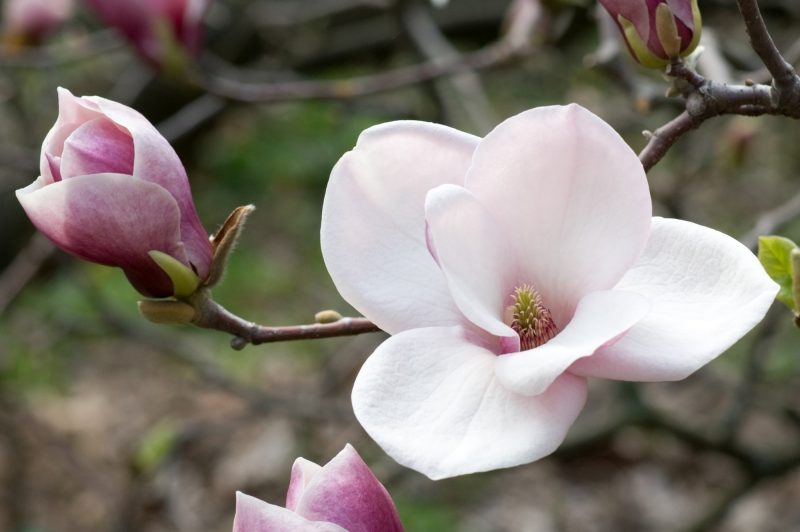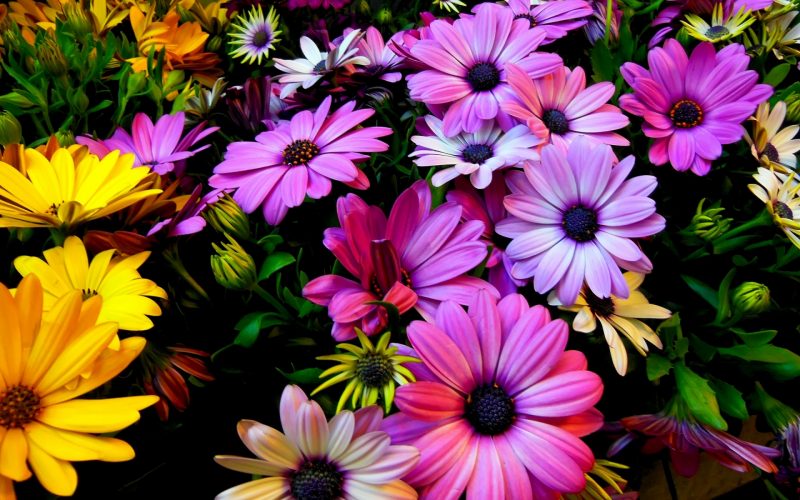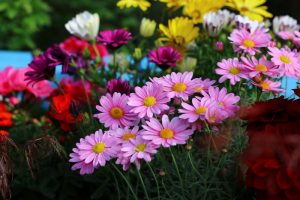Since many decades ago,flowers have become one of the main elements on varied occasions. From wedding to graduation parties, the beautiful plants are always present. They bring some meanings and symbols. Some of you might wonder about how many types of flowers in the world. So, for the details, learn more about it here.
1. Daisy Flower

Daisy flower goes with white petals and yellow focal point. Sometimes it’s rose or pink. Its evergreen leaves are narrow and serrated.
Often grown outdoors, daisy can give color to your entire home garden. The flower contains several meanings like innocence and purity.

When it comes to grow daisy flower, you need to know that it doesn’t like living in a soggy environment. Also, feeding it with a balanced fertilizer is another factor you can’t skip out. The best time to grow this charming lady is in the early or mid-spring.
2. Poppy Flower

Poppy flower is one of the types of flowers that belongs to the family of Papaveraceae. The short-lived perennial is comprised of 4 to 6 colorful petals.
They look eye-catching making the garden landscape outstanding.Interestingly, some of them died after the blooming moment.

As it’s classified as a herbaceous plant, the flower is often applied in the medical purpose. Back in the day when World War II took place, poppy flower became the remembrance icon addressed to soldiers passing away in the tough battle. The seeds it produces even can be consumed.
3. Sweet Pea Flower

Not only used in garden decoration, but sweet pea flower is also often found in bouquets and flower arrangement. Native to southern Italy, this floral species is highlighted due to its striking, colorful sheets.
The annual climbing plant with pinnate leaves comes with height reaching up to two meters.
How to take care of it? It turns out that the graceful European flower requires full sun and moist soil before growing it, ensure that you soak the seeds first for about 24 hours. Grow it in the early spring.
4. Narcissus Flower (Daffodil)

Narcissus flower has multifarious names such as daffodil and jonquil. It successfully grabs the people’s attention due to its lovely physical appearance. In a traditional term, this plant is available in two shades, i.e. yellow and white. The six petals surround a trumpet-shaped corona.

This flower matches your green home garden. You can take full advantage of it as a border decoration. The first thing you have to do to grow this flower is preparing the flower bulb.
Then, plant it in an area with partial shade. Give the site a space ranging from 3 to 6 inches.
5. Camellia Flower

Camelia flower is characterized by conspicuous, expansive flowers as well as glossy, serrated leaves. At a glance, the dark green, wide foliages look like tea leaves. Meanwhile, the flowers are various in colors such as red, pink, and white. In nature, the shrub thrives well under mild climate.
The flowering plant of which height ranging from 6 to 12 feet tall requires any sun exposure – it can be full sun or partial shade. The blooming time usually takes place in the late autumn to the mid-spring. To grow it, be sure that you choose an area that’s free from wind.
6. Dahlia

Known as a herbaceous plant, Dahlia is flowers enthusiasts’ favorite flowers. The flashy blossoms, from crimson red to peachy pink, literally are attractive. The sizes are also found to be wide-ranging, from dinner plates to lollipops. The tuberous-rooted plant is grown in spring.
The blooming time usually takes place in June and July. For the growing site, select the one that gets full sun exposure and doesn’t let the wind ruin the flowers. Another note is that the size of the growing hall is a bit bigger than the plant’s root ball.
7. Daylilies

Daylily is one of the types of flowers that should be present in your backyard to add spice. The flowering plant is best planted anytime within spring and fall. Uniquely, the blossoms start to appear during the sun rises and shrivel in the following night. It’s native to eastern Asia.
The cultivars of daylilies are miscellaneous, producing sweet-smelling aroma. Unfortunately, one of the species can be toxic to cats. If the furry animals ingest the flower, they can experience something like getting depressed and isolated.
8. Forget-Me-Nots

Don’t misinterpret that – as it’s another name of exotic flowers called Scorpion grasses. The small flowers contain five flatly faced petals of which shade vary from blue, pink, and white. The center of the gorgeous flowers is yellow.
Scorpion grasses come with multiple meanings. In relation to a romantic setting; it means the significance of undying and true love. It also symbolizes loyalty in a relationship. When the bright flowers are linked to the history, it has an affiliation with the genocide of Armenian armies.
9. Evening Primrose

As its name suggests, the blossoms only begin to open during the evening time. The herbaceous species from the family of Onagraceae is also called sundrops and suncups.
The color variety of goblet-like flowers includes yellow, white, as well as pink. Native to America, this sort of flower can even thrive well in infertile soil and less water. There is no wonder that it can survive in the drought time.
10. Freesia

Creating the most sweet-scented aroma, freesia is often applied in some beauty products including shampoos and lotions. When it comes to description, freesia flower is characterized by funnel-shaped tepals relatively narrow. It grows from a conical bulbo-tuber.
Originating from the eastern side of Africa, freesia flower frequently opens when summer comes. The multi-colored living jewel doesn’t require much water in the care, and the growing medium is typically well-drained soil rich in nutrient.
11. Gardenia

Gardenia belongs to the family of Rubiaceae. The shrub can reach the height ranging from one to fifteen meters. The flowers are commonly either white or pale yellow. They are highly fragrant making people want to smell it. Meanwhile, the leaves are broad, glossy, and dark green.
Gardenia plants can serve as borders and hedges. Interestingly, one of its species called Gardenia thunbergia, generates hard, woody fruits. To grow gardenia, be sure that you provide organic soil that’s drained perfectly. To support the growth of the flower, you can apply acid fertilizer.
12. Gladiolus

Gladiolus is such an elegant addition to your summer bouquets. It’s available in several types of color such as orange, white, pink, and yellow. The evergreen leaves are narrow and sword-shaped. The flowering plant’s height ranges from 2 to 5 feet tall. The taller one is often placed in the garden’s back.
Unlike other types of flowers, it grows from a rounded corm. To grow that, it’s important that you know the time. Spring, when the temperature gets warmer, is the right time to plant Gladiolus. Apply a garden fork to loosen the soil so that you can make a small hole (to place the corm).
13. Geraniums

Geraniums are also known as cranesbills are a type of perennial plant that loves living in an area with a moderate temperature. In nature, it’s mostly found in the eastern part of the Mediterranean region. The flower itself is comprised of five petals and varying in color from purple to pink.
Generally speaking, there are two ways of propagation. The first one is by sowing the seeds and the second one is by stem cutting. Caring for it is another factor you can’t take lightly. You must know that watering the plant properly is very important.
14. Hibiscus

Hibiscus can add a tropical charm to your garden. It comes with some names such rose of Sharon, hardy hibiscus, as well as tropical hibiscus. The flowers are pretty expansive and various in color such as peach, red, yellow, and purple. One flower consists of 5 petals.
As the plant is native to the tropical region; make sure that you provide a growing setting that’s relatively warmer. When dealing with another benefit, it’s found that hibiscus is applied as a herbal tea. Have you ever known Roselle? This red brewed herbal tea is popular among tea lovers.
15. Hyacinths

Unlike other types of flowers that attached to the branch, hyacinths uniquely grow from the bulb. Belonging to the lily family, the flowers are shaped in a bell along with some lovely petals. The waxy blossoms come with varieties in color such as salmon,peach, yellow, purple, and red.
When the leaves are highlighted, the best description of them is that they go with strap shape, green color, and glossy surface. The blossoms usually open within months between March and April.
16. Hydrangea

Hydrangea is a colorful flowering plant that can be either evergreen or deciduous. One of the interesting facts is that hydrangea flower develops elegantly in the flower heads. Flower heads are classified into two parts – big flashy flowers with tepals and the small ones, non-showy.
Yes, it’s true that hydrangea is mostly found in a white color. Apart from it, some species are found to be various in colors, including light purple, blue, pink, and many others. How the flowers’ color can change highly is determined by the existence of aluminum soils in the ground.
17. Lavender

True to its name, lavender gets its charm by its magnificent shade. Well-known among gardeners, lavender is often used in a multiplicity of products such as essential oils, lavender tea, as well as lavender tea.
Aside from its flashy set of purple flowers, this plant is one of the types of flowers that have unique linear leaves combining the shades of grey and green. To propagate the cute flower, you can both directly cut or divide the roots.
18. Lilac

Can’t be away from purple color? Lilac is a great flower to collect. Also known as syringa, the lilac flower is comprised of a collection of the four-lobed beautiful corolla. Unlike other types of flowers, this graceful blossom grows in expansive panicles. Some species are strongly sweet-scented.
The shrubs are commonly grown either in a public park or in a home garden, captivating the people who passed by. Lilac also has a connection with some symbols. In Cyprus, the flower has a close relation to the Easter time.
19. Lily

Who doesn’t know Lily? In many cultures, lily flower is highly appreciated. When it comes to appearances, Lily comes with large flowers varying in shades such as orange, white, yellow, purple, and red – and they have a good fragrance. It’s great to make your indoor setting
The blooming season usually takes place in early spring or late summer. To grow Lily, the choice of soil highly matters. You must know that lily requires a type of soil that’s porous, loamy, and well-drained as well.
20. Lupine

In the United States, most people delight in the beauty of the lupine flower. The shape of the flowers is spiral, and they are densely-packed in multiple types of colors such as purple, red, orange, and white.
Lupine needs full sun to grow and develop. What about the growing medium? It turns out that this flower can’t tolerate a type of soil that has a high level of alkalinity. Spacing is another factor you need to take care.
21. Magnolia

Interestingly, Magnolia is one of the types of flowers that considered the most ancient in the world. The graceful flowers scattered across America and West Indies, go with petals that are strap-shaped. The variation of the color includes pink, white, and purple.

The unique side of Magnolia is that it generates reddish-brown, cone-like fruits and the seeds look like kidneys. To grow this flower, be sure that you provide a large space.
Those are 21 type of flowers that will make your day more colorful. Their presence also adds color to their surroundings.



